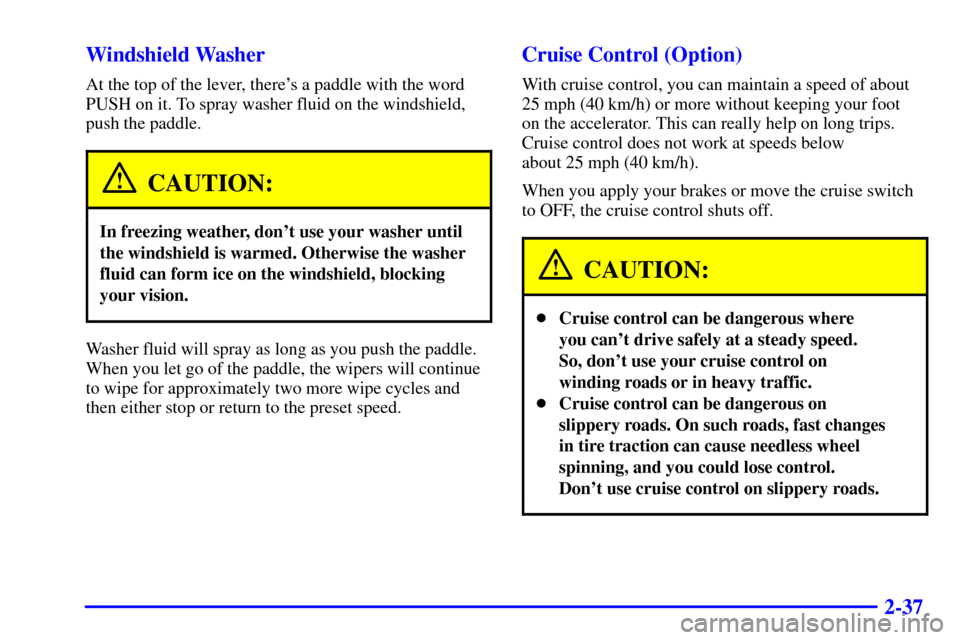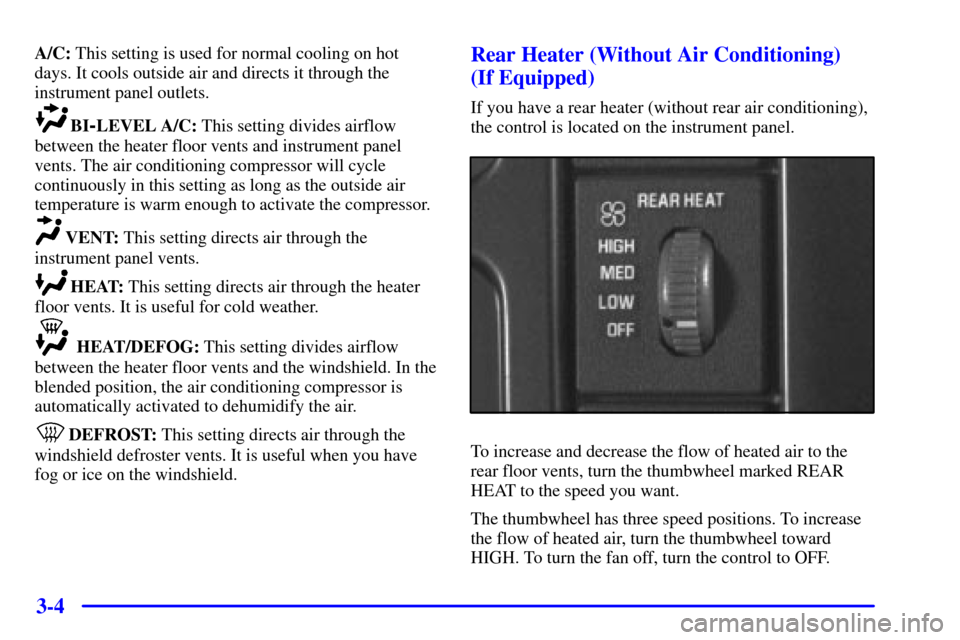Page 111 of 412
2-34
Tilt Wheel (Option)
A tilt steering wheel allows you to adjust the steering
wheel before you drive. You can also raise it to the
highest level to give your legs more room when you
enter and exit the vehicle.
To tilt the wheel, hold the steering wheel and pull the
lever. Move the steering wheel to a comfortable level,
then release the lever to lock the wheel in place.
Turn Signal/Multifunction Lever
The lever on the left side of the steering column
includes the following:
�Turn and Lane Change Signals
�Headlamp High/Low
-Beam Changer
�Windshield Wipers
�Windshield Washer
�Cruise Control (Option)
Page 114 of 412

2-37 Windshield Washer
At the top of the lever, there's a paddle with the word
PUSH on it. To spray washer fluid on the windshield,
push the paddle.
CAUTION:
In freezing weather, don't use your washer until
the windshield is warmed. Otherwise the washer
fluid can form ice on the windshield, blocking
your vision.
Washer fluid will spray as long as you push the paddle.
When you let go of the paddle, the wipers will continue
to wipe for approximately two more wipe cycles and
then either stop or return to the preset speed.
Cruise Control (Option)
With cruise control, you can maintain a speed of about
25 mph (40 km/h) or more without keeping your foot
on the accelerator. This can really help on long trips.
Cruise control does not work at speeds below
about 25 mph (40 km/h).
When you apply your brakes or move the cruise switch
to OFF, the cruise control shuts off.
CAUTION:
�Cruise control can be dangerous where
you can't drive safely at a steady speed.
So, don't use your cruise control on
winding roads or in heavy traffic.
�Cruise control can be dangerous on
slippery roads. On such roads, fast changes
in tire traction can cause needless wheel
spinning, and you could lose control.
Don't use cruise control on slippery roads.
Page 117 of 412

2-40
Exterior Lamps
Your parking lamp/headlamp switch is on the driver's
side of your instrument panel.
Your instrument panel dimmer thumbwheel has
two detent positions.
When the thumbwheel is moved to the first detent
position, the radio display and transmission selection
display will go to full intensity. The rest of the
instrument panel light will be lit dimly. Moving the
thumbwheel up one more detent will activate the
interior dome lamps.The vehicle is also equipped with a DOME OVERRIDE
button. For more information on this feature see
ªDome Lampsº in the Index.
The delayed entry feature will allow you to enter or exit
your vehicle with the lights on for about 20 seconds,
after the door is closed or the ignition is cycled.
Turn the knob clockwise to the parking lamp symbol to
turn on the following:
�Parking Lamps
�Sidemarker Lamps
�Taillamps
�License Plate Lamps
�Instrument Panel Lights
�Ashtray Lamp
Turn the knob clockwise again to the master lighting
symbol to turn on all the lamps listed above as well as
the headlamps.
Turn the knob counterclockwise to OFF to turn off your
lamps and lights.
Page 118 of 412

2-41
You can switch your headlamps from high to low beam
by pulling on the turn signal/high beam lever.
A circuit breaker protects your headlamps. If you have
an electrical overload, your headlamps will flicker on
and off. Have your headlamp wiring checked right away
if this happens.
Headlamps On Reminder
A tone will sound when your headlamps are turned on
and your ignition is in OFF, LOCK or ACCESSORY.
If you need to use your headlamps when the ignition
switch is in OFF, LOCK or ACCESSORY, the tone
can be turned off by moving the thumbwheel next to the
parking lamp/headlamp switch all the way down.
Daytime Running Lamps
Daytime Running Lamps (DRL) can make it easier for
others to see the front of your vehicle during the day.
DRL can be helpful in many different driving
conditions, but they can be especially helpful in the
short periods after dawn and before sunset. Fully
functional daytime running lights are required on all
vehicles first sold in Canada.The DRL system will make your headlamps come
on at a reduced brightness when the following
conditions are met:
�The ignition is on,
�The headlamp switch is off, and
�The parking brake is released.
When the DRL are on, only your headlamps will be on.
The taillamps, sidemarker and other lamps won't be on.
Your instrument panel won't be lit up either.
When it begins to get dark, your DRL indicator light
is a reminder to turn your headlamp switch on. The
other lamps that come on with your headlamps will
also come on.
When you turn off the headlamp switch, the regular
lamps will go off, and your headlamps will change to
the reduced brightness of DRL.
To idle your vehicle with the engine on and the DRL off,
set the parking brake. The DRL will stay off until you
release the parking brake.
As with any vehicle, you should turn on the regular
headlamp system when you need it.
Page 119 of 412
2-42 Center High-Mounted Stoplamp
Your vehicle's center high-mounted stoplamp is located
above the rear doors at the center of the vehicle.
If items are loaded on the roof of the vehicle, as in a
luggage carrier, care should be taken not to block or
damage the center high
-mounted stoplamp unit.
Interior Lamps
Dome Lamps
The dome lamps will come on when you open a door.
You can also turn the dome lamps on by moving the
thumbwheel, located next to the headlamp knob, all the
way up to the second detent. In this position, the dome
lamps will remain on whether a door is open or closed.
Page 148 of 412

3-4
A/C: This setting is used for normal cooling on hot
days. It cools outside air and directs it through the
instrument panel outlets.
BI-LEVEL A/C: This setting divides airflow
between the heater floor vents and instrument panel
vents. The air conditioning compressor will cycle
continuously in this setting as long as the outside air
temperature is warm enough to activate the compressor.
VENT: This setting directs air through the
instrument panel vents.
HEAT: This setting directs air through the heater
floor vents. It is useful for cold weather.
HEAT/DEFOG: This setting divides airflow
between the heater floor vents and the windshield. In the
blended position, the air conditioning compressor is
automatically activated to dehumidify the air.
DEFROST: This setting directs air through the
windshield defroster vents. It is useful when you have
fog or ice on the windshield.
Rear Heater (Without Air Conditioning)
(If Equipped)
If you have a rear heater (without rear air conditioning),
the control is located on the instrument panel.
To increase and decrease the flow of heated air to the
rear floor vents, turn the thumbwheel marked REAR
HEAT to the speed you want.
The thumbwheel has three speed positions. To increase
the flow of heated air, turn the thumbwheel toward
HIGH. To turn the fan off, turn the control to OFF.
Page 200 of 412
4-8
Here's how anti-lock works. Let's say the road is wet.
You're driving safely. Suddenly an animal jumps out in
front of you.
You slam on the brakes and continue braking. Here's
what happens with ABS.
A computer senses that wheels are slowing down. If one
of the wheels is about to stop rolling, the computer will
separately work the brakes at each front wheel and at
both rear wheels.The anti
-lock system can change the brake pressure
faster than any driver could. The computer is
programmed to make the most of available tire and road
conditions. This can help you steer around the obstacle
while braking hard.
As you brake, your computer keeps receiving updates on
wheel speed and controls braking pressure accordingly.
Page 201 of 412

4-9
Remember: Anti-lock doesn't change the time you need
to get your foot up to the brake pedal or always decrease
stopping distance. If you get too close to the vehicle in
front of you, you won't have time to apply your brakes
if that vehicle suddenly slows or stops. Always leave
enough room up ahead to stop, even though you have
anti
-lock brakes.
Using Anti
-Lock
Don't pump the brakes. Just hold the brake pedal down
firmly and let anti
-lock work for you. You may feel
the brakes vibrate, or you may notice some noise, but
this is normal.
Braking in Emergencies
With anti-lock, you can steer and brake at the same
time. In many emergencies, steering can help you
more than even the very best braking.
Steering
Power Steering
If you lose power steering assist because the engine
stops or the system is not functioning, you can steer
but it will take much more effort.
Steering Tips
Driving on Curves
It's important to take curves at a reasonable speed.
A lot of the ªdriver lost controlº accidents mentioned on
the news happen on curves. Here's why:
Experienced driver or beginner, each of us is subject to
the same laws of physics when driving on curves. The
traction of the tires against the road surface makes it
possible for the vehicle to change its path when you turn
the front wheels. If there's no traction, inertia will keep
the vehicle going in the same direction. If you've ever
tried to steer a vehicle on wet ice, you'll understand this.
The traction you can get in a curve depends on the
condition of your tires and the road surface, the angle
at which the curve is banked, and your speed.
While you're in a curve, speed is the one factor
you can control.